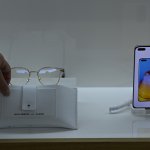Digital exhaust: putting data emissions to work

You put on a trench coat, slide a pair of dark glasses onto your face, throw on a hat, and pull down the brim over your eyes. The disguise may be good, but it won’t stop you from being recognized. What’s giving you away? Bluetooth signals in your digital exhaust. Data emissions from our digital devices can help companies to improve their services and better target customers, although some people may object to them.
Devices such as the smartphones we carry around for most of the day, every day, contain a Bluetooth chip with a unique id. These bits identify the manufacturer and give information on the type of chip. It’s a useful feature to have, as if there are any issues with the modules post-production then devices can be patched or recalled and replaced to restore functionality.
At the same time, these identifiers – if broadcast – can be logged to get an idea of whether a device has been in a certain location before. Security features such as address randomization are designed to make this more difficult, but even these schemes can still leave ‘identifying tokens’ in their digital exhaust– as experts discovered back in 2019 [PDF].
Other interesting data includes received signal strength indicator, or RSSI, values. If you are curious, you can observe these values for the devices around you right now by running a Bluetooth utility such as the bluetoothctl command line tool available on Linux operating systems. Smartphone apps can display this information too.
Location station
By arranging dedicated beacons in a triangle, operators can work out where a given Bluetooth device is, based on the signal strengths received. If the signal strength is showing up as roughly equal then the transmitting chip is somewhere in the middle of the arrangement. Or at least, that’s the best guess. RSSI values aren’t a perfect proxy for distance as reflections or obstacles in the way will make the setup think that the Bluetooth source is somewhere it isn’t. But it’s still a useful setup and researchers have found clever ways of boosting the accuracy of Bluetooth beacons, if required.
Bluetooth tracking can work well across a range of locations – from hotels to hospitals. And it’s worth keeping in mind the riches of data that retailers gather when you shop online to understand why collecting similar clues in a physical setting is good for business. Bluetooth tracking can provide big wins for operators – for example, hardware providers such as Estimote and Kontact offer systems designed to make spaces (factories, offices, healthcare facilities, and other sites) smarter.
Market research points to a rich ecosystem of tracking methods – for example, using standalone services or features built into weather or news apps. And if this is sounding somewhat scary to you, then you might be interested in Apple’s upcoming iOS release with its lockdown mode to resist tracking. Naturally, phone users have the power to turn off their Bluetooth service when walking around – although the trend for wireless headphones is rapidly rendering this an inconvenient option. That being said, mobile operating systems generally provide some granularity in their menu options so that Bluetooth can also be deactivated on an app-by-app basis (Apple’s privacy menu allows this). But even following those steps can still leave devices exposed to tracking, as a recent study by researchers in the US showed.
The team, members of the Wireless Communications Sensing and Networking group at the University of California San Diego, US, noticed that physical-layer imperfections in the Bluetooth chips themselves were sufficient to contribute a unique fingerprint that can be used to identify host devices. These signal imperfections require some expertise and a couple of hundred dollars of equipment to capture, but the researchers have shown that it can be done. And where there’s a will, there’s a way.
Artistic flair
Simon Weckert, a digital artist based in Germany, famously put the spotlight on Google’s use of mobile phones to pinpoint traffic congestion by dragging a trolley full of devices behind him as he walked around Berlin. His actions easily fooled the US search engine’s algorithms into thinking that the route he was taking was gridlocked with traffic. In fact, as his images showed, for most of his stroll around the German capital, Weckert was often completely alone. But thanks to the bundle of phones behind him, the digital exhaust he was trailing said otherwise.
Confused cameras
Weckert isn’t the only artist to have some fun confusing computer systems fed by data grabbed from the environment around them. Before him, in 2010, US researcher Adam Harvey – who studied computational photography and technology at New York University – worked out that he could bamboozle image recognition algorithms by using bold stripes of makeup. The work grabbed the attention of security guru Bruce Schneier, who’s renowned for having wise words to say on matters of technology security.
Harvey’s approach was successful because it forced image recognition algorithms to take missteps and think that they’ve found the bridge of a subject’s nose, or other key anchor points, when in fact they were looking at a patch of makeup. However, there’s evidence that these methods don’t work for long though. During the global pandemic, when mask-wearing become much more common to slow down the spread of the virus, facial recognition systems became similarly confused. But security researchers noticed that algorithms were able to adapt to the changes and find other facial characteristics to lock onto.
Security screening
Recognizing what poses a threat and what doesn’t could turn out to be a major use of digital exhaust data. A study presented at last year’s ‘Hot Topics in the Science of Security’ set the scene for using radio frequency fingerprints – run through a machine learning classifier – as a mechanism for identifying rogue devices. And other teams are busy exploring the idea too.









